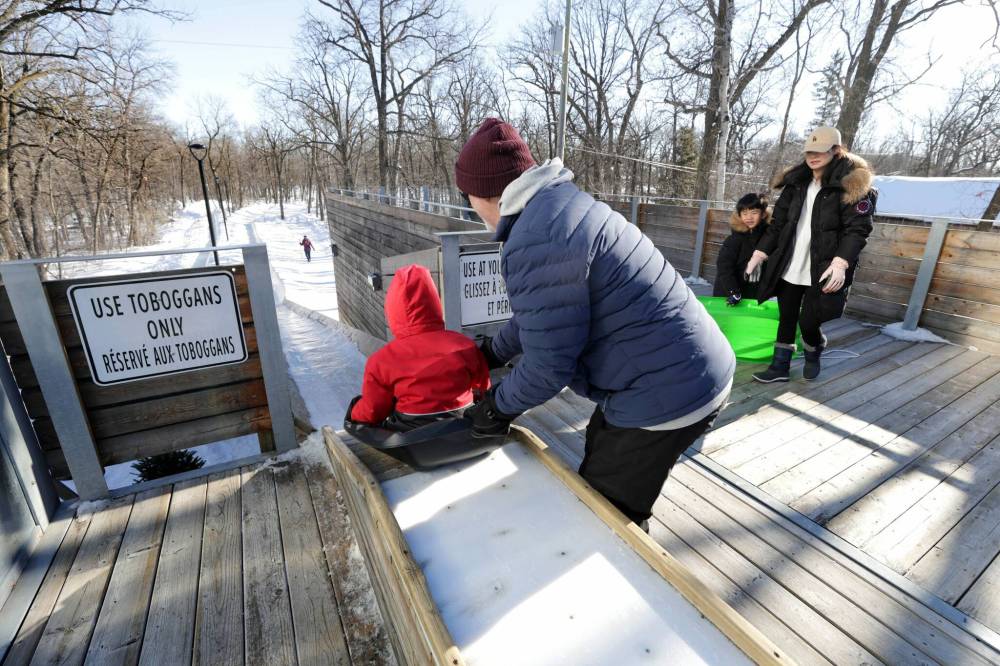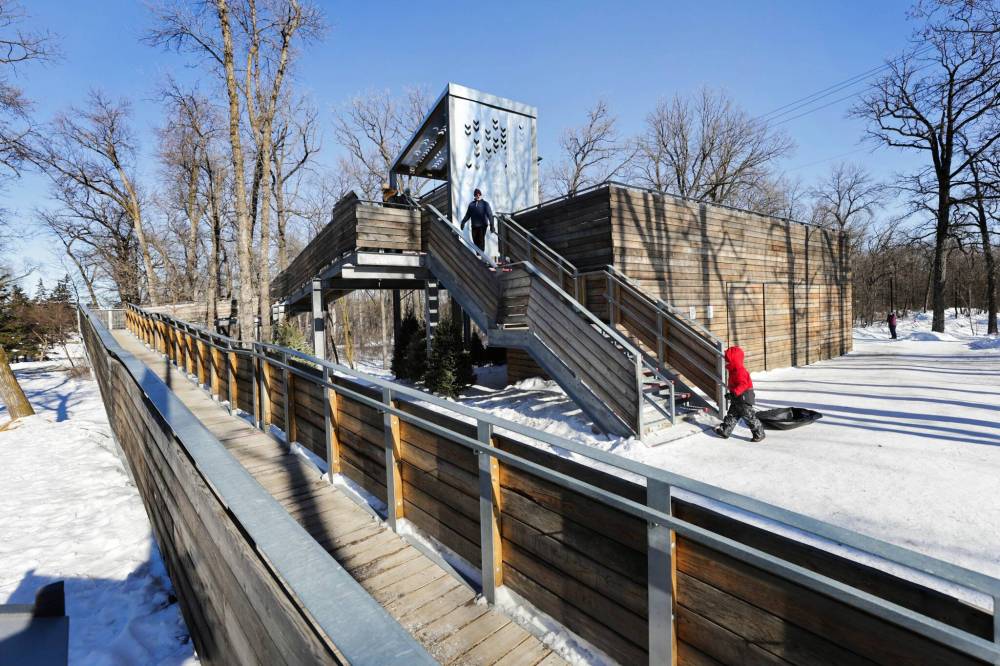This brrrrrrrilliant city
Public City’s Manitoboggan and Crokicurl are exactly what Winter Cities Shake-up Conference hopes to encourage
Advertisement
Read this article for free:
or
Already have an account? Log in here »
To continue reading, please subscribe:
Monthly Digital Subscription
$0 for the first 4 weeks*
- Enjoy unlimited reading on winnipegfreepress.com
- Read the E-Edition, our digital replica newspaper
- Access News Break, our award-winning app
- Play interactive puzzles
*No charge for 4 weeks then price increases to the regular rate of $19.00 plus GST every four weeks. Offer available to new and qualified returning subscribers only. Cancel any time.
Monthly Digital Subscription
$4.75/week*
- Enjoy unlimited reading on winnipegfreepress.com
- Read the E-Edition, our digital replica newspaper
- Access News Break, our award-winning app
- Play interactive puzzles
*Billed as $19 plus GST every four weeks. Cancel any time.
To continue reading, please subscribe:
Add Free Press access to your Brandon Sun subscription for only an additional
$1 for the first 4 weeks*
*Your next subscription payment will increase by $1.00 and you will be charged $16.99 plus GST for four weeks. After four weeks, your payment will increase to $23.99 plus GST every four weeks.
Read unlimited articles for free today:
or
Already have an account? Log in here »
Hey there, time traveller!
This article was published 12/02/2023 (1020 days ago), so information in it may no longer be current.
This week, from Feb. 15-17, Winnipeg is hosting the 2023 Winter Cities Shake-up Conference, which features designers, planners, entrepreneurs, tourism operators, cultural workers, community organizers and happiness experts talking about how cities and their citizens can make the most of winter.
The Winter City movement brings together people from northern latitude cities — places that experience months of cold days and long nights. In terms of design, the movement sometimes deals with technical issues — how to plan structures and streets to minimize wind and maximize sun, how to ensure transportation systems hold up to cold-weather demands, how to find creative outdoor lighting strategies when darkness falls at 4 p.m.
Edmonton’s detailed Winter City guidelines even include snow-plowing protocols to decrease windrows on private sidewalks and driveways, something most Winnipeggers could get behind.

RUTH BONNEVILLE / WINNIPEG FREE PRESS
The multi-level Manitoboggan at St. Vital Park features an accessible ramp and metal grates on walkways to reduce snow accumulation.
But the Winter City movement is also very much about encouraging a shift in attitude. Winter City advocates want people to stop hibernating and start celebrating.
It’s the kind of approach we’ve seen in Winnipeg in recent years with expanded winter facilities at The Forks, a river skating trail that has extended to world-record-setting lengths, and more than a decade of the popular Warming Huts project.
It’s expressed through cold-weather events such as the long-running Festival du Voyageur, which has been winter-positive since 1970, and RAW:almond, which started in 2013 and brings together diners and chefs from Winnipeg, across Canada and around the world to share meals in a temporary structure on the frozen Assiniboine. (After its three-year hiatus, tickets for the event’s much anticipated 2023 return quickly sold out.)
And sometimes winter-forward design can be as simple and modest and fun as a well-constructed wood and galvanized-steel toboggan slide. Take Manitoboggan, designed by Public City Architecture in 2017, which now functions as a winter recreation hub in St. Vital Park. For Public City’s principal partners, architect Peter Sampson and landscape architect Liz Wreford, who was lead designer on the project, Manitoboggan is a reminder of why free, accessible public spaces are essential to city life, and why in Winnipeg these spaces need to work in wintertime — maybe even especially in wintertime.
Manitoboggan has received an Award of Merit at the 2022 Prairie Design Awards and a 2020 Award of Excellence from the Canadian Society of Landscape Architects. It was recognized by the International Olympic Committee in 2019, as well as by the International Paralympic Committee, in acknowledgment of its barrier-free and universally accessible design.
The experience of designing and constructing Manitoboggan was good for Public City, Wreford believes. “It opened up new kinds of thinking about what public space could be and should be in Winnipeg,” she says.
Hugging a bend in the Red, St. Vital Park offers curving pathways and beautifully framed river views. A recent visit on a winter Saturday was a reminder that what Winnipeggers often call our “green spaces” — our public parks and playgrounds and sports fields — are, for much of the year, not green at all. They’re white, covered in a blanket of snow, which is why projects like Manitoboggan are so crucial.
According to Wreford, who has worked in Seattle and Australia: “As a landscape architect, it’s a different profession here. The drastic change of the landscape from one six months to the other six months — it’s a challenge. But if you can do it in the winter, the summer’s easy.
“And it’s important to see winter as an opportunity, instead of a thing we have to get through.”

RUTH BONNEVILLE / WINNIPEG FREE PRESS
Manitoboggan’s iced chutes, with banked-up sides, make for a fast and thrilling ride. If you visit on a busy afternoon, you’ll hear a lot of joyful screaming.
Manitoboggan starts with a common Prairie tobogganing plight. We may get tons of snow, but we have very few naturally occurring slopes. In Guy Maddin’s 2007 docu-fantasia My Winnipeg, for instance, the filmmaker gets a lot of mythic mileage from the fact that Garbage Hill, one of our town’s best-known sliding areas, was constructed by putting sod over a former dump. In other neighbourhoods, kids sled on dikes built for flood protection.
Not having a pre-existing hill to work with, Public City has built one, with two chutes at different heights. The iced chutes, with banked-up sides, make for a fast slide — if you visit on a busy afternoon, you’ll probably hear a lot of happy screaming — but one that levels out and then curves around at the bottom to bring tobogganers to an easy stop.
The way up is also thoughtfully designed. Along with the stairs, with metal grates on the steps to discourage snow accumulation, there is a universally accessible ramp.
“The day it opened, Billy Bridges [the sledge hockey player and medal-winning Paralympian] came to the opening with his little girl, and it was such a great experience because he hadn’t gone tobogganing with her, ever,” Wreford recalls. “He was able to get up to the top and go down, and he was really excited.”
The structure’s upper canopy is incised with motifs that riff on Mary Maxim sweaters and their warming connotations. With roots in Sifton, Man., in the 1950s, the company is known for producing iconic vintage knitting patterns, and its sweaters have been popular on Prairie curling rinks for decades and are now prized thrift-store finds.
Manitoboggan includes a ground-level warming area, with an interior painted a welcoming red. In the summer, the doors can swing wide open, and the space functions as a picnic shelter. The ramp, while allowing for accessible tobogganing in winter, also functions as a treetop walkway and lookout year-round, offering high-up views down to the nearby river. “It really speaks to here,” Sampson suggests. “It accepts that we need three different kinds of room, in a seasonal shift that goes from 30 below to 30 above — one for the temperate climate, and one for the really cold climate, and one for the shoulder seasons in-between.
“It’s paying attention to where it is, and here things have to be adaptable.”
Confirming the notion that if you build it, they will come, Manitoboggan has increased the number of visitors to St. Vital Park, which for Wreford and Sampson means they’ve done their job. “We want to design stuff that makes people look forward to winter, have happy associations with winter,” Wreford says. “If we can’t find joy in what we’re doing, then we’re not doing it right. That goes for winter or summer, but here it has to include winter.”
It’s fun, but it’s serious fun. Public City wants to use public spaces to bring people together, boost social engagement and make Winnipeg a more connected city. That approach is manifested in Crokicurl, another Public City project. A hybrid sport played on a large outdoor octagon of ice, Crokicurl mashes up crokinole, a much-loved cottage-country board game, and curling, and was invented by Wreford and colleague Leanne Muir.

RUTH BONNEVILLE / WINNIPEG FREE PRESS
Public City Architecture credits their design and construction of Manitoboggan for opening up ‘new kinds of thinking about what public space could be and should be in Winnipeg.’
It debuted at The Forks in 2017 and has since spread to dozens of Canadian cities and towns. “Once it was built, it was amazing how quickly it caught on,” Wreford relates. “Because it was a new thing everybody could do in the winter. And it was new for everyone, so no one was an expert. Every age and ability could do it. New Canadians were interested in doing it. We were all learning it together. It was like a social commons.”
With happy projects like Manitoboggan and Crokicurl, Public City uses design to shift people’s attitudes to winter in Winnipeg. “The era of apologizing for being a winter city, or being embarrassed about it, is over,” Sampson states. “Winnipeg needs to believe in itself as a winter city. We’re an awesome and unprecedented winter city, and we need to put energy and policy and city-building best practices toward that kind of thinking.”
As Wreford says, “There is something so special about this place in the winter. When we show people in other places, people are amazed at what we have.”
We should be, too.
alison.gillmor@freepress.mb.ca

Studying at the University of Winnipeg and later Toronto’s York University, Alison Gillmor planned to become an art historian. She ended up catching the journalism bug when she started as visual arts reviewer at the Winnipeg Free Press in 1992.
Our newsroom depends on a growing audience of readers to power our journalism. If you are not a paid reader, please consider becoming a subscriber.
Our newsroom depends on its audience of readers to power our journalism. Thank you for your support.










